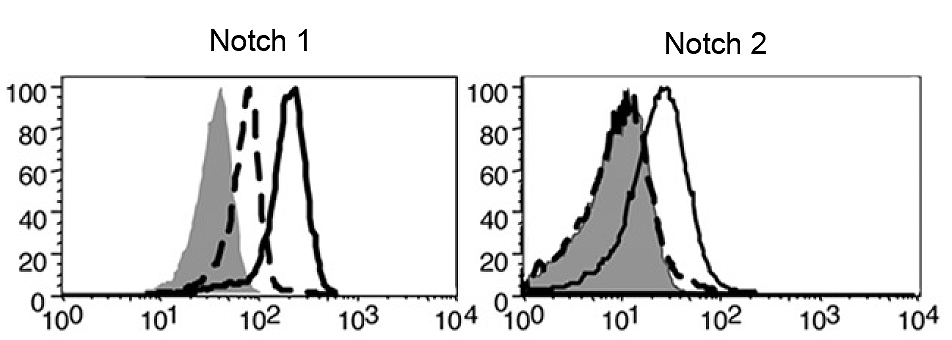
Detection of endogenous mouse Notch 1 or Notch 2 on resting and activated T cells with anti-Notch1 (mouse), mAb (22E5) (Prod. No. AG-20B-0051) and anti-Notch2, mAb (16F11) (Prod. No. AG-20B-0052), respectively. Method: CD4+ T cells from C57BL/6 mic
anti-Notch2, mAb (16F11)
AG-20B-0052
ApplicationsFlow Cytometry
Product group Antibodies
ReactivityHuman, Mouse
TargetNotch2
Overview
- SupplierAdipoGen Life Sciences
- Product Nameanti-Notch2, mAb (16F11)
- Delivery Days Customer10
- ApplicationsFlow Cytometry
- CertificationResearch Use Only
- ClonalityMonoclonal
- Clone ID16F11
- Concentration1 mg/ml
- Estimated Purity>95%
- Gene ID18129
- Target nameNotch2
- Target descriptionnotch 2
- Target synonymsN2, neurogenic locus notch homolog protein 2, Motch B, Notch gene homolog 2
- HostRat
- IsotypeIgG1
- Protein IDO35516
- Protein NameNeurogenic locus notch homolog protein 2
- Scientific DescriptionMonoclonal Antibody. Recognizes human and mouse endogenous Notch-2 receptor. Isotype: Rat IgG1kappa. Clone: 16F11. Applications: FACS. Liquid. In PBS containing 10% glycerol and 0.02% sodium azide. Notch signaling pathway regulates many different cell fate decisions in both vertebrate and invertebrate species. There are 5 canonical Notch ligands in mammals: Jagged-1, Jagged-2, DLL1, DLL3 and DLL4. These can bind to the four Notch receptors Notch 1-4. It is important for pattern formation during development such as neurogenesis, angiogenesis or myogenesis and regulates T cell development and stem cell maintenance. Notch signaling is also involved in cellular processes through-out adulthood. Signaling via Notch occurs between neighbouring cells and both the receptor and its ligands are transmembrane proteins. - Notch signaling pathway regulates many different cell fate decisions in both vertebrate and invertebrate species. There are 5 canonical Notch ligands in mammals: Jagged-1, Jagged-2, DLL1, DLL3 and DLL4. These can bind to the four Notch receptors Notch 1-4. It is important for pattern formation during development such as neurogenesis, angiogenesis or myogenesis and regulates T cell development and stem cell maintenance. Notch signaling is also involved in cellular processes through-out adulthood. Signaling via Notch occurs between neighbouring cells and both the receptor and its ligands are transmembrane proteins.
- ReactivityHuman, Mouse
- Storage Instruction-20°C,2°C to 8°C
- UNSPSC12352203

![FACS analysis of mouse Notch 2 transfected cells using GTX39545 Notch 2 antibody [HMN2-35].](https://www.genetex.com/upload/website/prouct_img/normal/GTX39545/GTX39545_5081_FACS_w_23060819_667.webp)